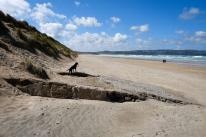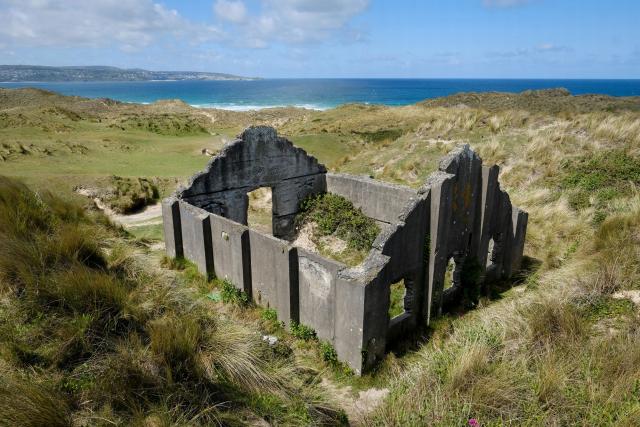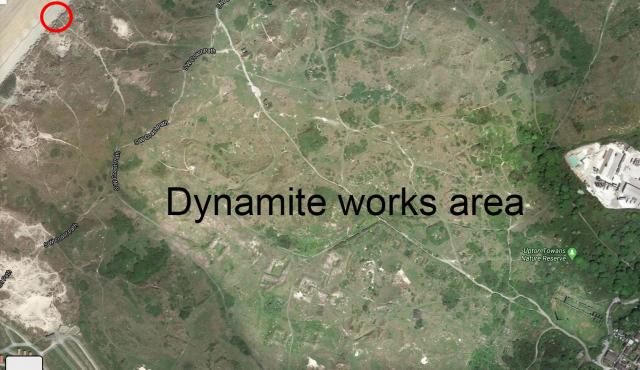200505 | Mystery road appears in middle of West Country beach
Mystery road appears in middle of West Country beach
There are various arguments to why it is there
 The mystery road that has appeared (Image: Greg Martin)
The mystery road that has appeared (Image: Greg Martin)Mystery surrounds the appearance of a road leading onto the beach on the coast of Cornwall during lockdown.
Photojournalist Greg Martin for Cornwall Live has been digging into the strange sight that has appeared near the village of Gwithian's with many claims being given into what it was for.
Gwithian’s stunning three miles of uninterrupted golden sands are now interrupted halfway along by a strange granite and concrete road, which comes out from the bottom of a 20ft high sand dune, before gently sloping down into the beach.
This is what he found out.
With no obvious reason for being there, the nearest proper road being over one kilometre away, and nothing at the top of the sand dune cliff which stretches for a mile in either direction, this latest addition to the beach near Hayle has got many people scratching their heads.
However, this is not the first time Gwithian’s road to nowhere has emerged from the sand. And now, some people think they know why this short and inaccessible highway to Hayle is there.
Walkers out for their one dose of daily exercise during lockdown began noticing the 25ft long stretch of road emerging from the sand several weeks ago. Looking very much like some sort of slipway, it seems out of place, with no obvious access to it.

Although some people say it has been uncovered for some time now, others say that it appears and disappears as the sands shift, with 2014 being the last time it was really exposed.
Every time this short road reveals itself, there is conjecture over why it is there, right in the middle of Cornwall’s longest beach. Some have suggested it was a slipway for Hayle’s first lifeboat, Isis, in 1866. Whilst others have speculated that it was put there far more recently, to cover up pipe work for the Wave Hub.
Most guesses associate this little road, which looks like a driveway that has lost its house, with either World War One or World War Two. Unsurprising, as the Towans at Hayle were very active during both wars.

Not far inland from the slipway at Upton Towans are the remains of the National Explosives factory, which was built in 1888 to produce dynamite for the Cornish mining industry and later became a major supplier of the explosive cordite to the Royal Navy in the First World War.
In 1889 the factory employed 175 people, but during the First World War this number increased over ten times to 1,800, the majority of whom were women.
The sand dunes at Upton Towans were an ideal landscape for making explosives. They could absorb the blast of any accidental explosions, and the falling ground levels were perfect for nitroglycerine production.

Although most of the structures have gone since the factory was closed down in 1920, there are still four roofless buildings hidden within the dunes, which are believed to possibly be the earliest known surviving group of mass-concrete magazines.
Some of these store houses for explosives were said to have been used right up until the 1960s.
Google satellite images show the slipway covered with sand, and probably unnoticeable at ground level. However, it is still possible to make out the shape of the road under the sand.
via https://www.somersetlive.co.uk/news/uk-world-news/cornwall-beach-road-gw...
- Printer-friendly version
- Login or register to post comments
- Permalink
Contributions
- Angarrack Defibrillator Team (25)
- Angarrack Inn (336)
- Angarrack Methodist Chapel (3)
- Carol (15)
- Gail (1)
- GordonG (12)
- Hayle Development Group on Facebook (5)
- Hayle Harbour Authority (4)
- Hayle Town Council (5)
- louise (1)
- Lynne (94)
- Mal (1)
- Neil (22)
- Neils Garden Care (9)
- Russell (21)
- Secretary - Christmas Lights (118)
- Steve (3)
- webmaster (5023)
Book page
Similar
- PA19/03365/PREAPP | Godrevy Spatial Plan: diversion existing access road, relocation existing headland car park to Godrevy Farm
- 200323 | Visitor facilities, car park and café improvements | Godrevy Car Park, Godrevy Towans, Gwithian
- 190831 | Owner distraught after horrific acid attack on dog in Cornwall
- 190724 | National Explosives Factory protected on advice from Historic England
- 180515 | Eight Cornwall beaches join official list of bathing waters for new season - Cornwall Live
Similar across site
- 200505 | Mystery road appears in middle of West Country beach
- PA19/03365/PREAPP | Godrevy Spatial Plan: diversion existing access road, relocation existing headland car park to Godrevy Farm
- 200323 | Visitor facilities, car park and café improvements | Godrevy Car Park, Godrevy Towans, Gwithian
- 190831 | Owner distraught after horrific acid attack on dog in Cornwall
- 190724 | National Explosives Factory protected on advice from Historic England
RNLI
- Sennen and Penlee Lifeboats launch to reported upturned vessel off Land's End
- St Agnes RNLI Christmas Card Sale & Coffee Morning
- £1M fund helps Penlee RNLI volunteer learn lifesaving skills
- RNLI issues safety advice as 2016 lifeguard season draws to a close
- RNLI Around the Mount Open Water Swim a resounding success!
- RNLI Around the Mount Open Water Swim 2016











Recent comments
6 days 17 hours ago
36 weeks 3 days ago
38 weeks 1 day ago
38 weeks 1 day ago
47 weeks 6 days ago
1 year 8 weeks ago
1 year 32 weeks ago
1 year 42 weeks ago
2 years 2 weeks ago
3 years 27 weeks ago